HR Professional Skills: CPID, Group Dynamics, Conflict Resolution Plan
VerifiedAdded on 2023/06/12

Human Resource Professional
Name of the Student
Name of the University
Author’s note
Paraphrase This Document
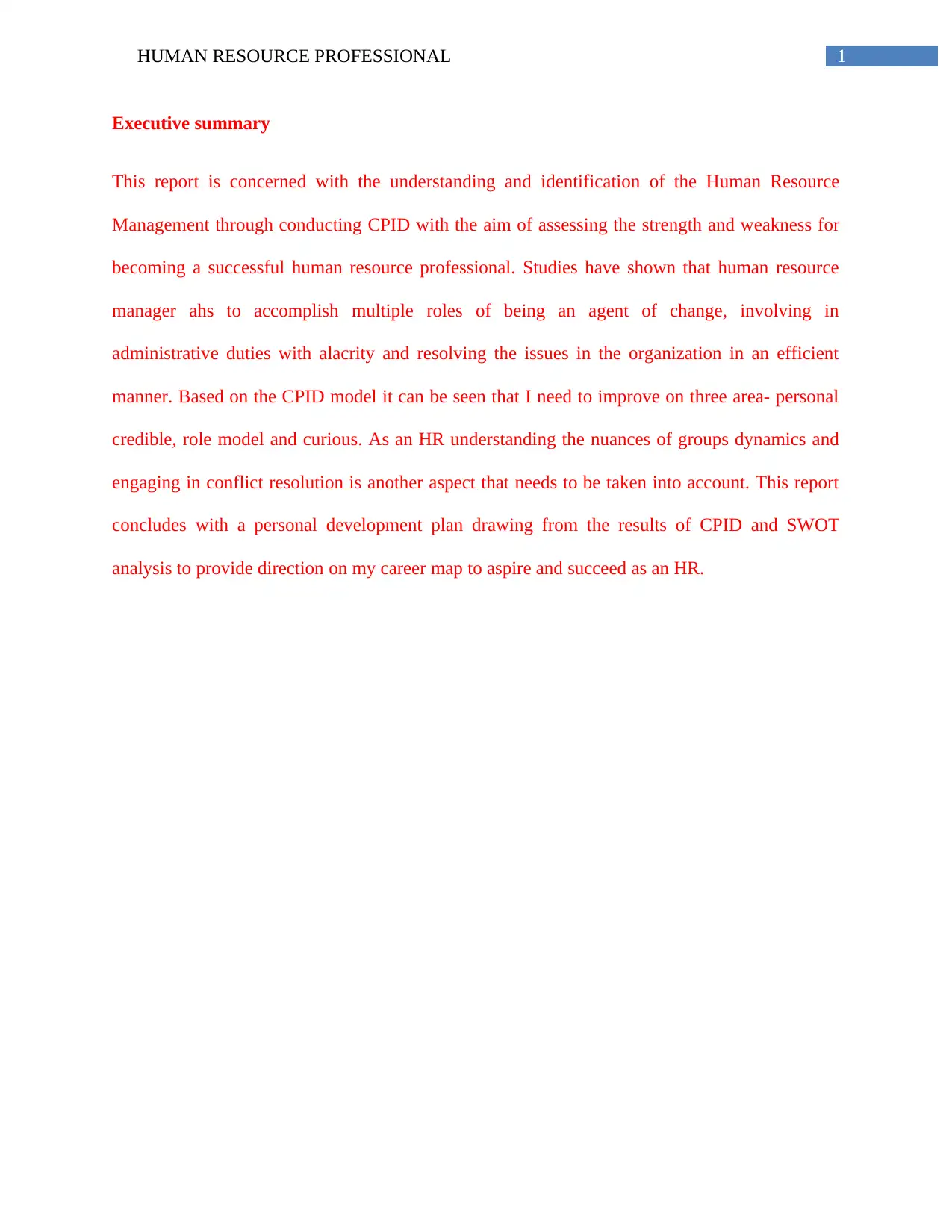
Executive summary
This report is concerned with the understanding and identification of the Human Resource
Management through conducting CPID with the aim of assessing the strength and weakness for
becoming a successful human resource professional. Studies have shown that human resource
manager ahs to accomplish multiple roles of being an agent of change, involving in
administrative duties with alacrity and resolving the issues in the organization in an efficient
manner. Based on the CPID model it can be seen that I need to improve on three area- personal
credible, role model and curious. As an HR understanding the nuances of groups dynamics and
engaging in conflict resolution is another aspect that needs to be taken into account. This report
concludes with a personal development plan drawing from the results of CPID and SWOT
analysis to provide direction on my career map to aspire and succeed as an HR.
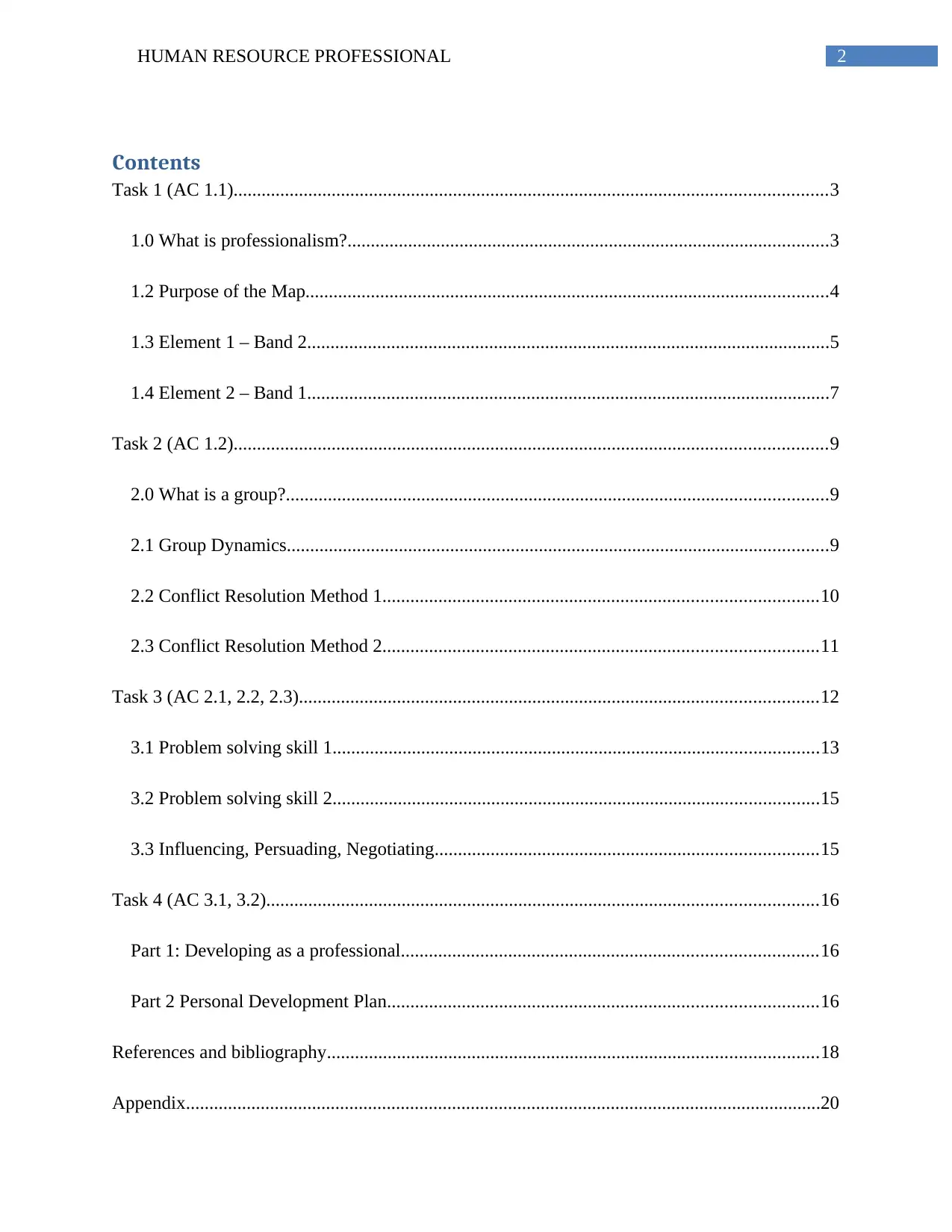
Contents
Task 1 (AC 1.1)...............................................................................................................................3
1.0 What is professionalism?.......................................................................................................3
1.2 Purpose of the Map................................................................................................................4
1.3 Element 1 – Band 2................................................................................................................5
1.4 Element 2 – Band 1................................................................................................................7
Task 2 (AC 1.2)...............................................................................................................................9
2.0 What is a group?....................................................................................................................9
2.1 Group Dynamics....................................................................................................................9
2.2 Conflict Resolution Method 1.............................................................................................10
2.3 Conflict Resolution Method 2.............................................................................................11
Task 3 (AC 2.1, 2.2, 2.3)...............................................................................................................12
3.1 Problem solving skill 1........................................................................................................13
3.2 Problem solving skill 2........................................................................................................15
3.3 Influencing, Persuading, Negotiating..................................................................................15
Task 4 (AC 3.1, 3.2)......................................................................................................................16
Part 1: Developing as a professional.........................................................................................16
Part 2 Personal Development Plan............................................................................................16
References and bibliography.........................................................................................................18
Appendix........................................................................................................................................20
⊘ This is a preview!⊘
Do you want full access?
Subscribe today to unlock all pages.

Trusted by 1+ million students worldwide
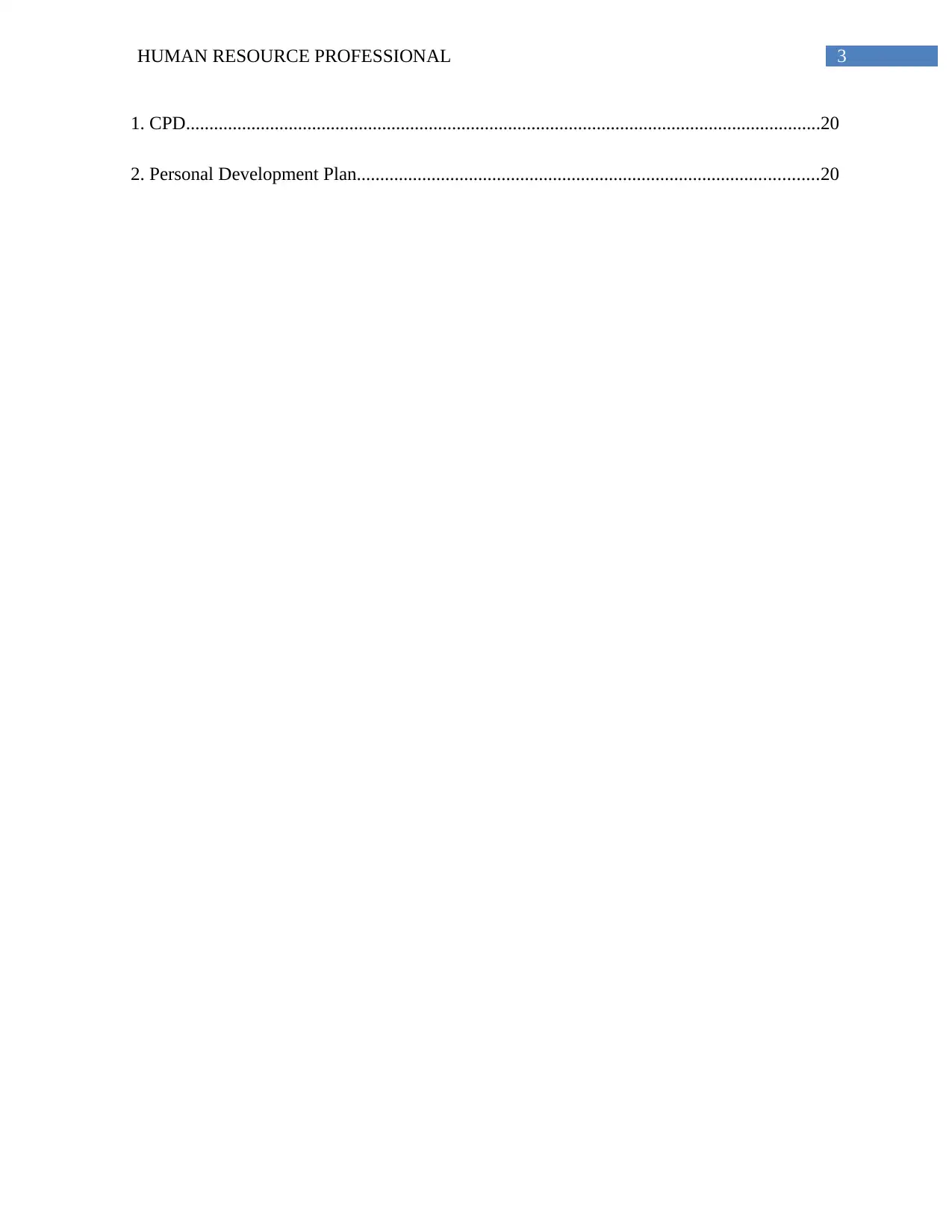
1. CPD........................................................................................................................................20
2. Personal Development Plan...................................................................................................20
Paraphrase This Document

Task 1 (AC 1.1)
1.1 Description of a HR professional
According to the recent spate of studies that emerged on human resources, it has been
found that human resource management has traversed a long way. As per the argument of CIPD
(2015), the remit of the function of the HR is expanding beyond the familiar territories of setting
the policies and supporting the line managers and providing expertise into the domains
innovation, brand and organizational knowledge. There has been an evolution in the profession
of HRM (Human Resource Management) and there is a new found motivation and aspiration
among the Human Resource Manager to embed its corporate strategy. The feeling in the
corporate world regarding the role and responsibility of the HRM (Human Resource Manager) is
that the person should essay the role of the leader in the development and implementation of the
business strategy. The tide of time ensues that the HR professionals should be at the forefront in
driving this solution. The key roles of the HR professional can be defined as being a strategic
partner, being an agent of change, being an administrative expert and being an employee
champion. There are new roles of the HR emerging in accordance with the line managers (Griggs
and Allen 2018).
There is an imperative to accomplish the goals of the administration along with ensuring
that the HR professionals are highly motivated in developing their personality that would foster
the future of the business. The rudimentary responsibility of the HR professional is to seek
methods and patterns of adding value dimension to the business enterprise. This element of the
HR professional can be understood through the notion of the thinking performer. The concept of
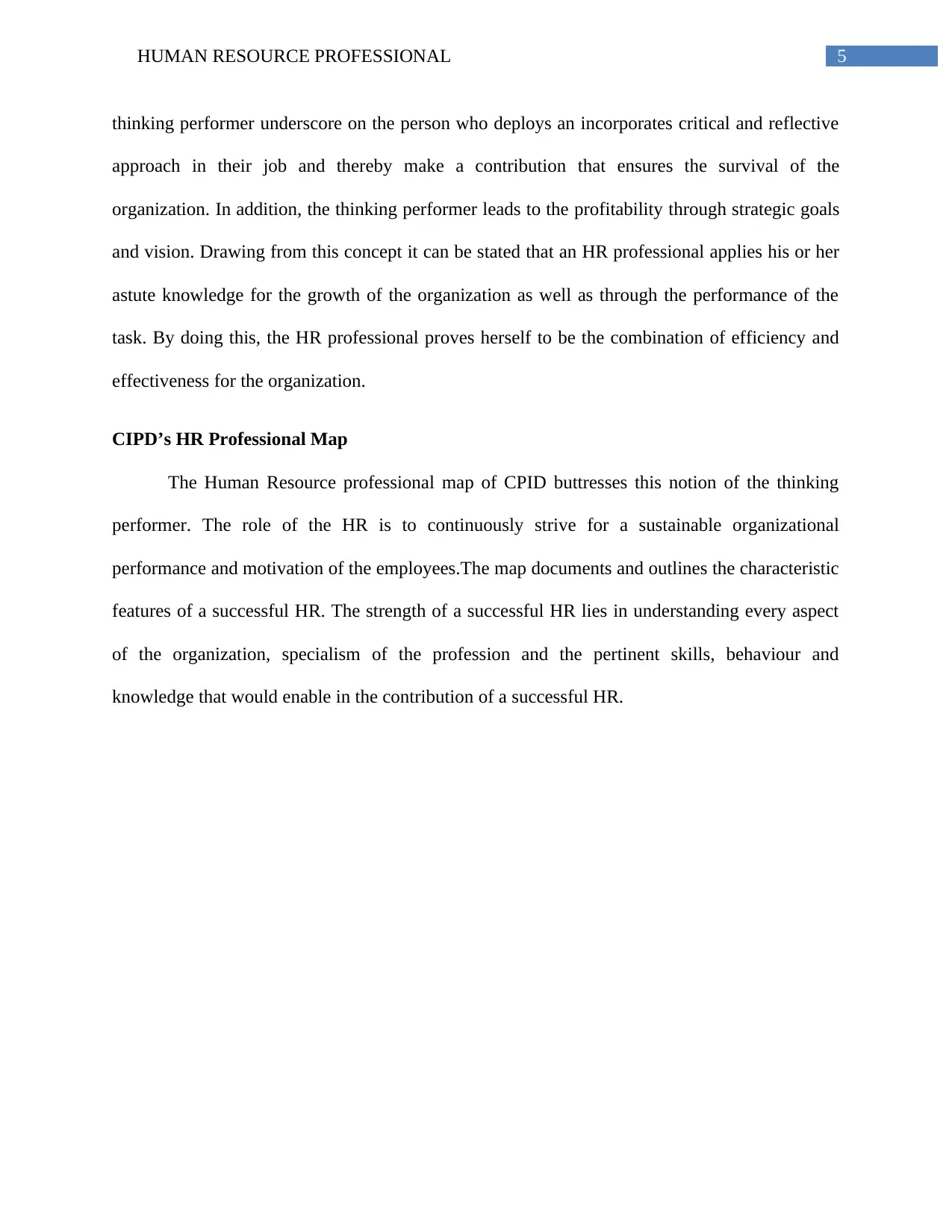
thinking performer underscore on the person who deploys an incorporates critical and reflective
approach in their job and thereby make a contribution that ensures the survival of the
organization. In addition, the thinking performer leads to the profitability through strategic goals
and vision. Drawing from this concept it can be stated that an HR professional applies his or her
astute knowledge for the growth of the organization as well as through the performance of the
task. By doing this, the HR professional proves herself to be the combination of efficiency and
effectiveness for the organization.
CIPD’s HR Professional Map
The Human Resource professional map of CPID buttresses this notion of the thinking
performer. The role of the HR is to continuously strive for a sustainable organizational
performance and motivation of the employees.The map documents and outlines the characteristic
features of a successful HR. The strength of a successful HR lies in understanding every aspect
of the organization, specialism of the profession and the pertinent skills, behaviour and
knowledge that would enable in the contribution of a successful HR.
⊘ This is a preview!⊘
Do you want full access?
Subscribe today to unlock all pages.

Trusted by 1+ million students worldwide

As an aspiring HR professional, I can deploy the bands of competence for the recognition
of the ways I am operating in my organization and functioning in the professional areas and
behaviours. This band will enable me to understand what steps do I need to adopt in the future to
become a successful HR professional. I can also use the CPID map tool to assess my strength,
weakness and personality elements in the map and use this for developing my key areas that
would facilitate me to progress in my career.
1.3 Personal Credible, Role Model and Curious – Band 2
If I am a professional in a different industry, I can use the CPID map to recognize and
identify the behaviours that I have used and developed in my career till now. As it can be seen
that I am in the category of band 2. There are three areas of behaviour where I need to work to
Paraphrase This Document
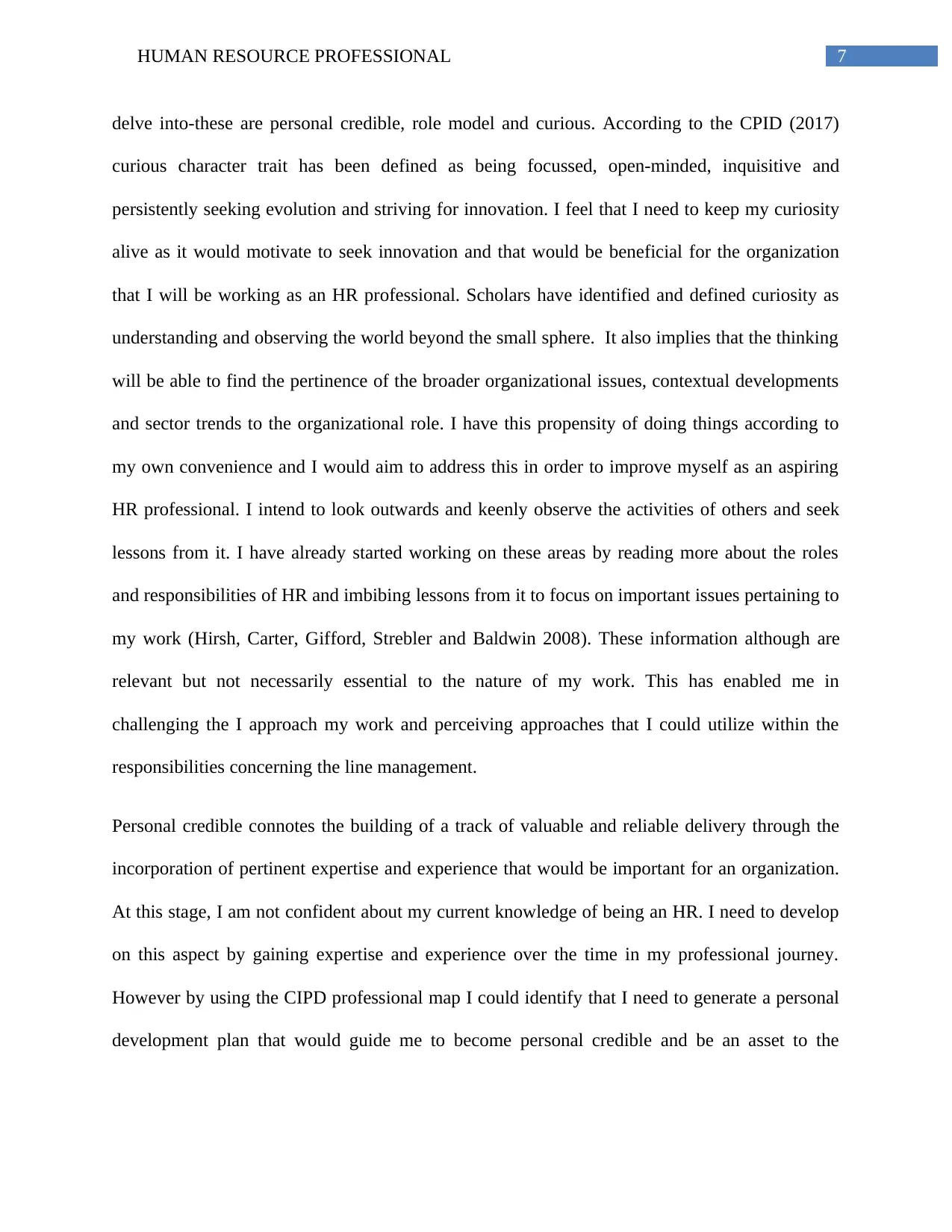
delve into-these are personal credible, role model and curious. According to the CPID (2017)
curious character trait has been defined as being focussed, open-minded, inquisitive and
persistently seeking evolution and striving for innovation. I feel that I need to keep my curiosity
alive as it would motivate to seek innovation and that would be beneficial for the organization
that I will be working as an HR professional. Scholars have identified and defined curiosity as
understanding and observing the world beyond the small sphere. It also implies that the thinking
will be able to find the pertinence of the broader organizational issues, contextual developments
and sector trends to the organizational role. I have this propensity of doing things according to
my own convenience and I would aim to address this in order to improve myself as an aspiring
HR professional. I intend to look outwards and keenly observe the activities of others and seek
lessons from it. I have already started working on these areas by reading more about the roles
and responsibilities of HR and imbibing lessons from it to focus on important issues pertaining to
my work (Hirsh, Carter, Gifford, Strebler and Baldwin 2008). These information although are
relevant but not necessarily essential to the nature of my work. This has enabled me in
challenging the I approach my work and perceiving approaches that I could utilize within the
responsibilities concerning the line management.
Personal credible connotes the building of a track of valuable and reliable delivery through the
incorporation of pertinent expertise and experience that would be important for an organization.
At this stage, I am not confident about my current knowledge of being an HR. I need to develop
on this aspect by gaining expertise and experience over the time in my professional journey.
However by using the CIPD professional map I could identify that I need to generate a personal
development plan that would guide me to become personal credible and be an asset to the
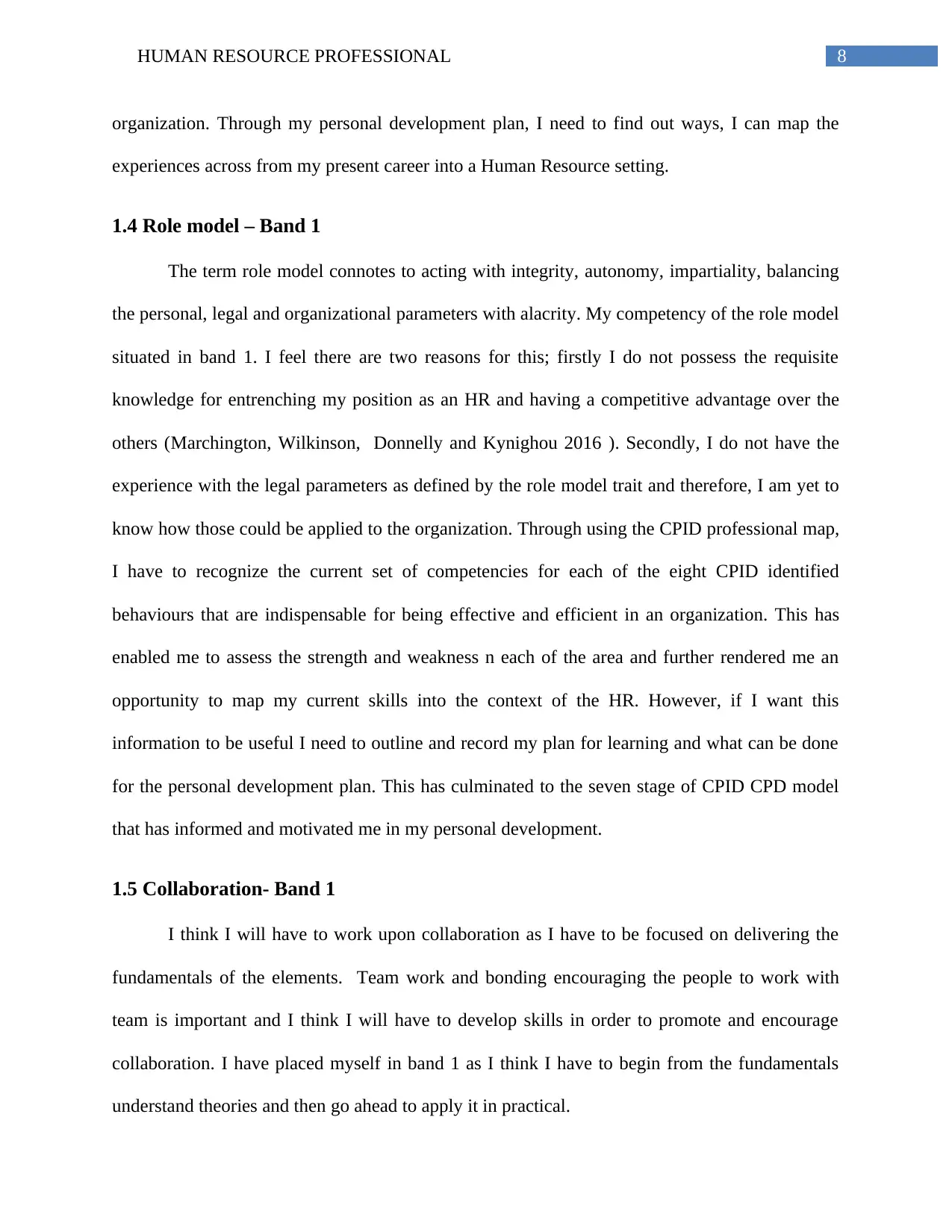
organization. Through my personal development plan, I need to find out ways, I can map the
experiences across from my present career into a Human Resource setting.
1.4 Role model – Band 1
The term role model connotes to acting with integrity, autonomy, impartiality, balancing
the personal, legal and organizational parameters with alacrity. My competency of the role model
situated in band 1. I feel there are two reasons for this; firstly I do not possess the requisite
knowledge for entrenching my position as an HR and having a competitive advantage over the
others (Marchington, Wilkinson, Donnelly and Kynighou 2016 ). Secondly, I do not have the
experience with the legal parameters as defined by the role model trait and therefore, I am yet to
know how those could be applied to the organization. Through using the CPID professional map,
I have to recognize the current set of competencies for each of the eight CPID identified
behaviours that are indispensable for being effective and efficient in an organization. This has
enabled me to assess the strength and weakness n each of the area and further rendered me an
opportunity to map my current skills into the context of the HR. However, if I want this
information to be useful I need to outline and record my plan for learning and what can be done
for the personal development plan. This has culminated to the seven stage of CPID CPD model
that has informed and motivated me in my personal development.
1.5 Collaboration- Band 1
I think I will have to work upon collaboration as I have to be focused on delivering the
fundamentals of the elements. Team work and bonding encouraging the people to work with
team is important and I think I will have to develop skills in order to promote and encourage
collaboration. I have placed myself in band 1 as I think I have to begin from the fundamentals
understand theories and then go ahead to apply it in practical.
⊘ This is a preview!⊘
Do you want full access?
Subscribe today to unlock all pages.

Trusted by 1+ million students worldwide
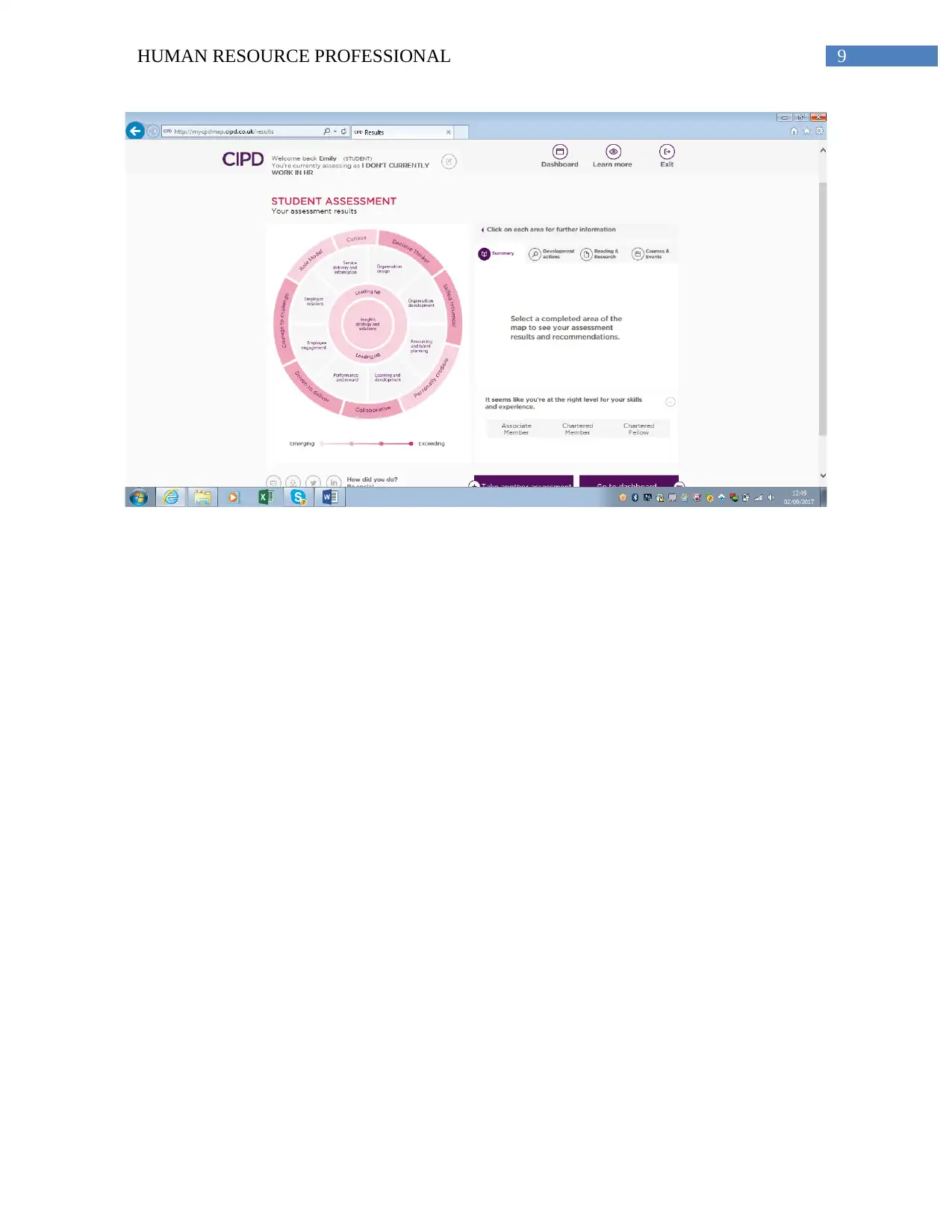
Paraphrase This Document

Task 2 (AC 1.2)
2.0 What is a group?
An individual needs the support of a team to achieve success as no individual can achieve
success on their own. It is the collective and concerted effort of the members of the organization
who contributes in the making of an individual who are working towards the achievement of the
goal and the agreed upon objectives.
2.1 Group Dynamics
In order to understand teamwork and success of the team, there is a need to understand
group dynamics. The term group dynamics connotes the study or use of process involved in him
when two people are interacting with one another. Scholars have engaged in intensive and astute
research regarding what constitutes the group dynamics and the formation of the successful team

and what a successful team would like. One key research in this area is that of Meredith
Belbinwho have worked on team dynamics during the 1970s. As per the findings of her study,
there are nine main teams; however the characteristic features of each of the teams are different
(Costanzo and Tzoumpa 2008). The highlight of the study is that it is these differences that
create a successful team. It was further found out in the study that it is not intellect but balance
that helps in the survival of the team.
2.2 Conflict Resolution with a consolidated team
A successful person or a leader should have these team roles but there is also the
possibility of one person embodying all these team goals. However, with the different behaviour
there may emerge stress and strain in the pursuit of the objectives. Each team member needs to
understand his or her role and responsibilities in the team, coordinate, work together and
understand the essence of the team bonding. However, if members in the team are unable to see
their roles in the team or understand their contributions may create conflict of interests within the
team. It will create contrasting views among the team members and will create difficulty in
understanding different viewpoints. There are eight kind of conflicts that have been identified by
the scholars. The eight typology of conflict are: conflicting goals, conflicting pressures,
conflicting perceptions, conflicting resources, conflicting styles, unpredictable policies and
different personal values. An illustration of conflict in my case was that two team members had
an argument in the meeting. This argument was followed by a heated verbal duel and one of the
members walked out of the room. This may be understood as conflict of styles and this kind of
situation demands mediation to resolve the issues.
The solution to this would be to understand the viewpoints of the other by closely
listening to their rationale for a particular decision or action. Taking into account the viewpoints
⊘ This is a preview!⊘
Do you want full access?
Subscribe today to unlock all pages.

Trusted by 1+ million students worldwide
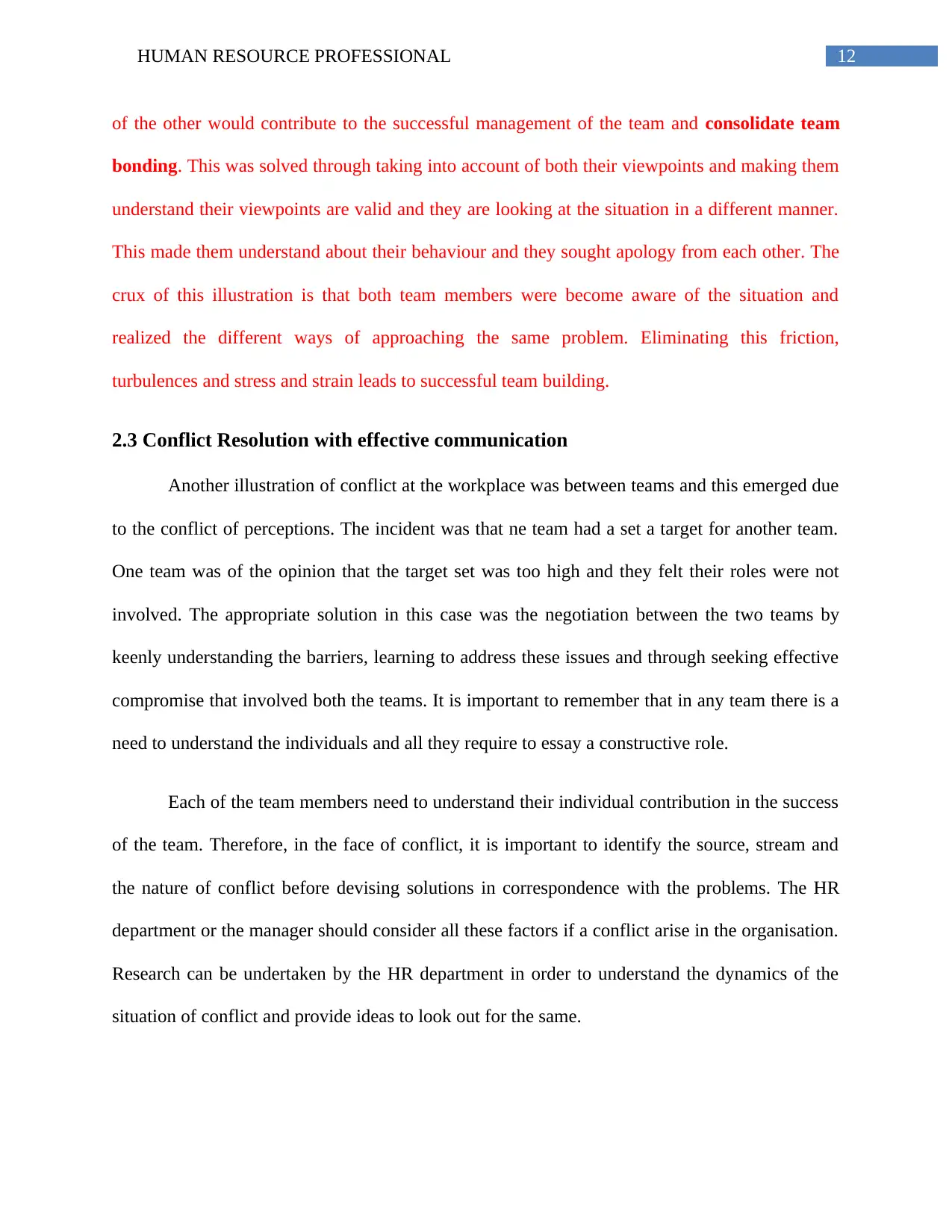
of the other would contribute to the successful management of the team and consolidate team
bonding. This was solved through taking into account of both their viewpoints and making them
understand their viewpoints are valid and they are looking at the situation in a different manner.
This made them understand about their behaviour and they sought apology from each other. The
crux of this illustration is that both team members were become aware of the situation and
realized the different ways of approaching the same problem. Eliminating this friction,
turbulences and stress and strain leads to successful team building.
2.3 Conflict Resolution with effective communication
Another illustration of conflict at the workplace was between teams and this emerged due
to the conflict of perceptions. The incident was that ne team had a set a target for another team.
One team was of the opinion that the target set was too high and they felt their roles were not
involved. The appropriate solution in this case was the negotiation between the two teams by
keenly understanding the barriers, learning to address these issues and through seeking effective
compromise that involved both the teams. It is important to remember that in any team there is a
need to understand the individuals and all they require to essay a constructive role.
Each of the team members need to understand their individual contribution in the success
of the team. Therefore, in the face of conflict, it is important to identify the source, stream and
the nature of conflict before devising solutions in correspondence with the problems. The HR
department or the manager should consider all these factors if a conflict arise in the organisation.
Research can be undertaken by the HR department in order to understand the dynamics of the
situation of conflict and provide ideas to look out for the same.
Paraphrase This Document

Task 3 (AC 2.1, 2.2, 2.3)
3.0 Definition of Project Management
Project management can be defined as the methodology that is applied in the process of
undertaking a project, it takes in account factors such as knowledge, skills and experience in
order to achieve the objective of the project.
Project I was associated with: Recently, I have completed a project in South Bristol at Hengrove
Park Leisure Centre. The problem that we identified was the poor programme that was set by the
Bristol City Council that was not effectively meeting any of the objectives as per the National
Governing Body of Aquatics. We wanted to have a swimming pool programme that would
enable in the promotion of swimming pool lessons, public swimming pool and support for a
pathway into the performance of swimming, water polo and synchronized swimming. As I was
the Southwest officer and my responsibility was leading the team with a set of small specialists
who would come together and create a swimming pool programme that could deliver our
strategic objectives. It was a challenge to ensure that all the stakeholders are involved and the
colleagues have fulfilled their respective roles with diligence during the project (Kerzner and
Kerzner 2017). To ensure coordination, clarity and management I prepared a Gantt chart
(attached below)
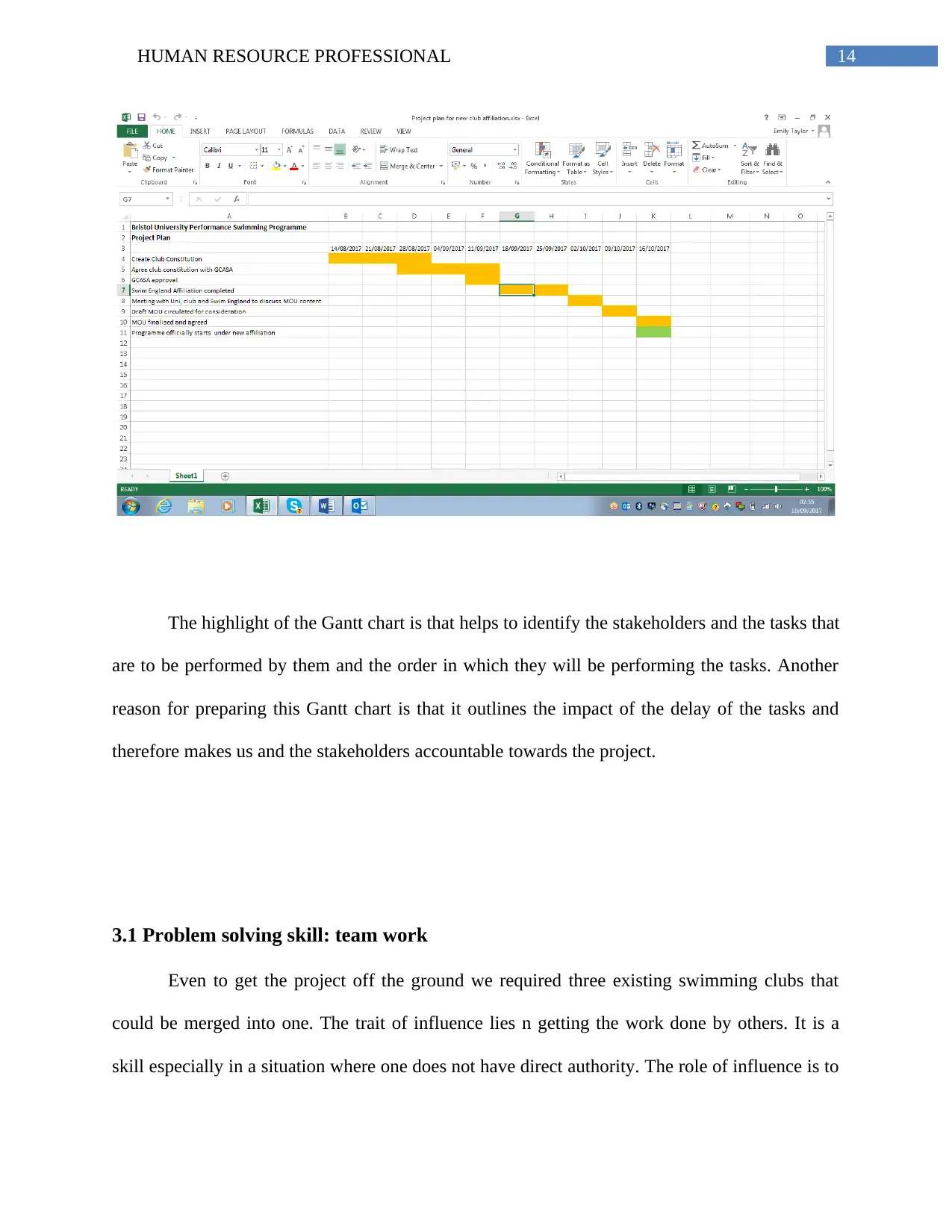
The highlight of the Gantt chart is that helps to identify the stakeholders and the tasks that
are to be performed by them and the order in which they will be performing the tasks. Another
reason for preparing this Gantt chart is that it outlines the impact of the delay of the tasks and
therefore makes us and the stakeholders accountable towards the project.
3.1 Problem solving skill: team work
Even to get the project off the ground we required three existing swimming clubs that
could be merged into one. The trait of influence lies n getting the work done by others. It is a
skill especially in a situation where one does not have direct authority. The role of influence is to
⊘ This is a preview!⊘
Do you want full access?
Subscribe today to unlock all pages.

Trusted by 1+ million students worldwide
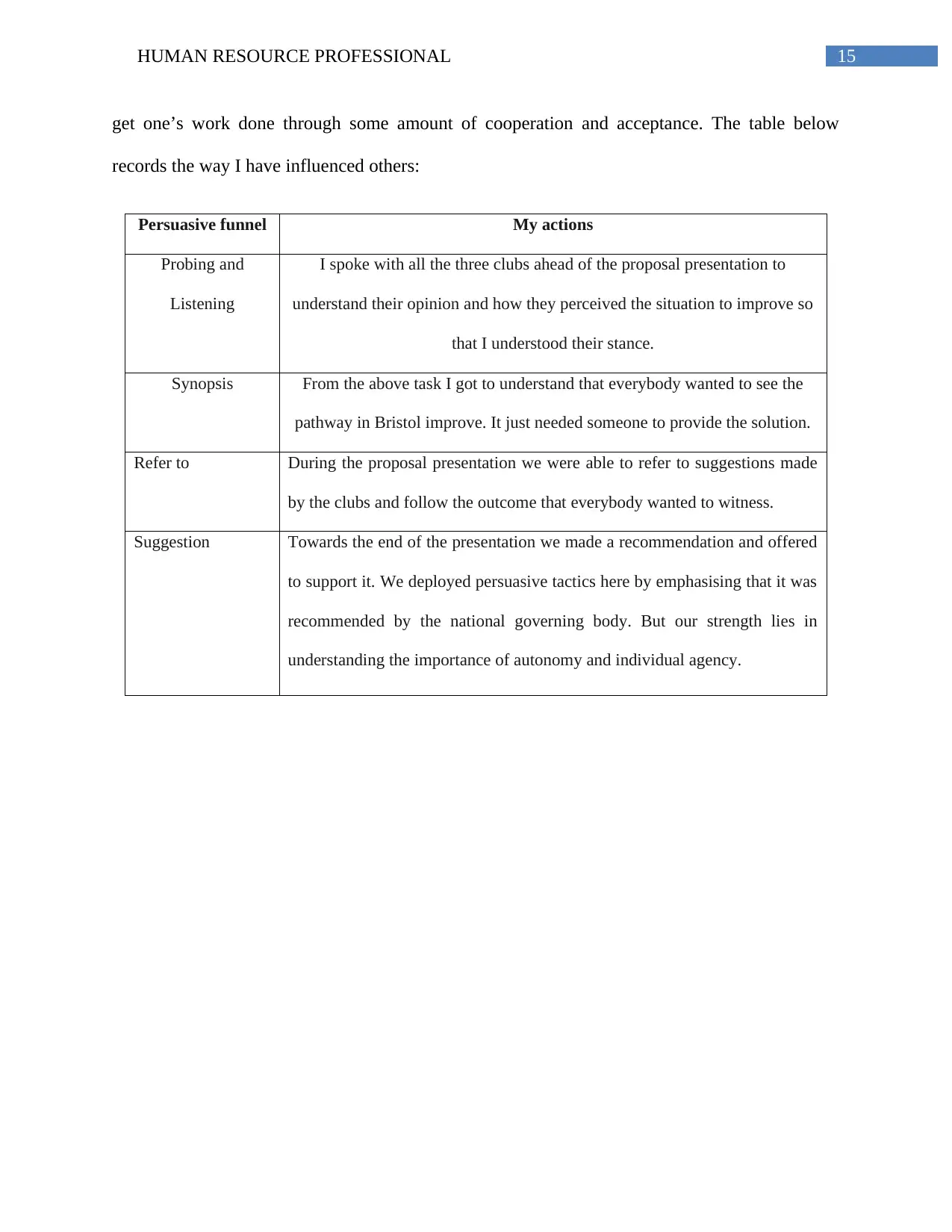
get one’s work done through some amount of cooperation and acceptance. The table below
records the way I have influenced others:
Persuasive funnel My actions
Probing and
Listening
I spoke with all the three clubs ahead of the proposal presentation to
understand their opinion and how they perceived the situation to improve so
that I understood their stance.
Synopsis From the above task I got to understand that everybody wanted to see the
pathway in Bristol improve. It just needed someone to provide the solution.
Refer to During the proposal presentation we were able to refer to suggestions made
by the clubs and follow the outcome that everybody wanted to witness.
Suggestion Towards the end of the presentation we made a recommendation and offered
to support it. We deployed persuasive tactics here by emphasising that it was
recommended by the national governing body. But our strength lies in
understanding the importance of autonomy and individual agency.
Paraphrase This Document
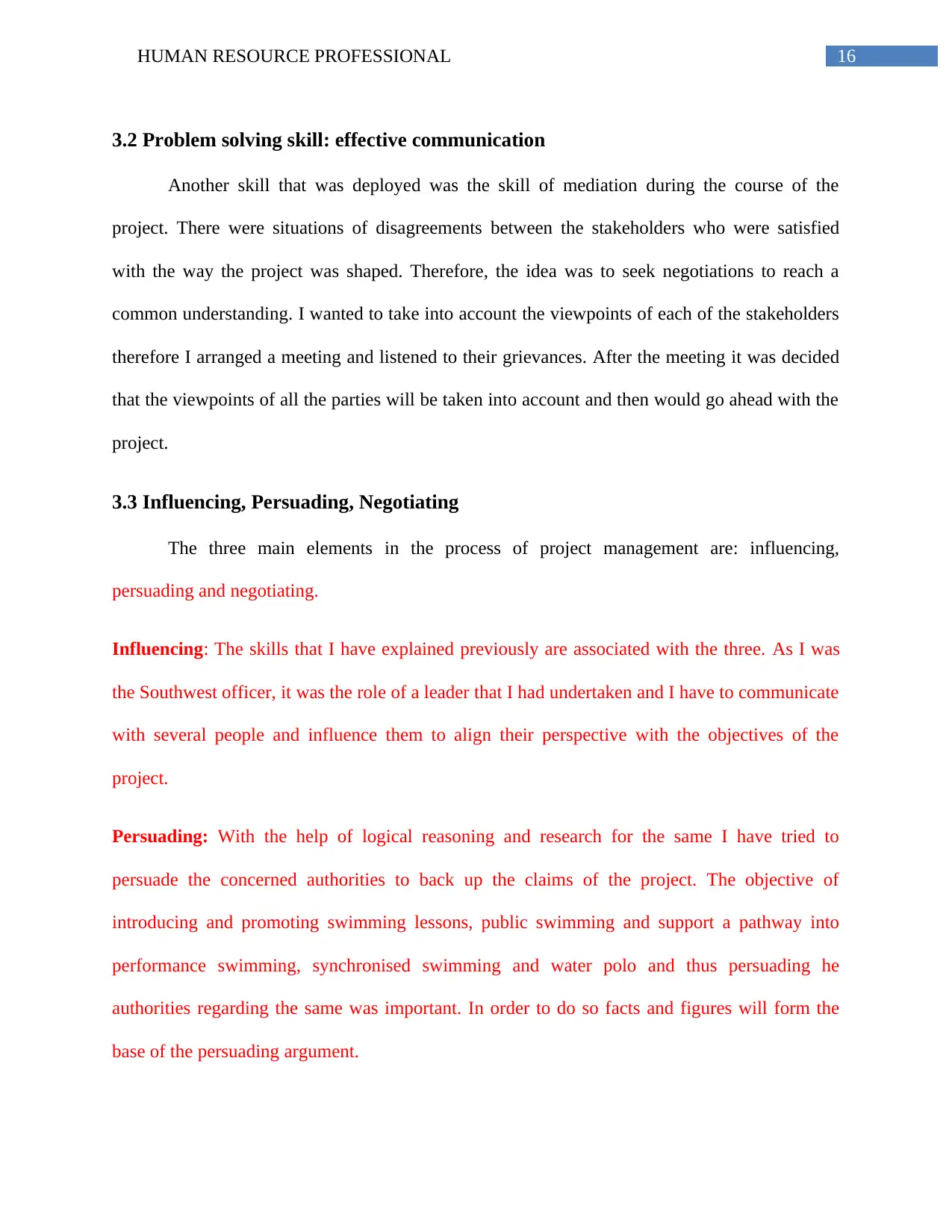
3.2 Problem solving skill: effective communication
Another skill that was deployed was the skill of mediation during the course of the
project. There were situations of disagreements between the stakeholders who were satisfied
with the way the project was shaped. Therefore, the idea was to seek negotiations to reach a
common understanding. I wanted to take into account the viewpoints of each of the stakeholders
therefore I arranged a meeting and listened to their grievances. After the meeting it was decided
that the viewpoints of all the parties will be taken into account and then would go ahead with the
project.
3.3 Influencing, Persuading, Negotiating
The three main elements in the process of project management are: influencing,
persuading and negotiating.
Influencing: The skills that I have explained previously are associated with the three. As I was
the Southwest officer, it was the role of a leader that I had undertaken and I have to communicate
with several people and influence them to align their perspective with the objectives of the
project.
Persuading: With the help of logical reasoning and research for the same I have tried to
persuade the concerned authorities to back up the claims of the project. The objective of
introducing and promoting swimming lessons, public swimming and support a pathway into
performance swimming, synchronised swimming and water polo and thus persuading he
authorities regarding the same was important. In order to do so facts and figures will form the
base of the persuading argument.

Negotiation: While formulating the objectives of Hengrove Park Leisure Centre, the authorities
were sure that all the objectives will not be solved in one project therefore this is where the
priorities had to be set and negotiation had taken place.
⊘ This is a preview!⊘
Do you want full access?
Subscribe today to unlock all pages.

Trusted by 1+ million students worldwide
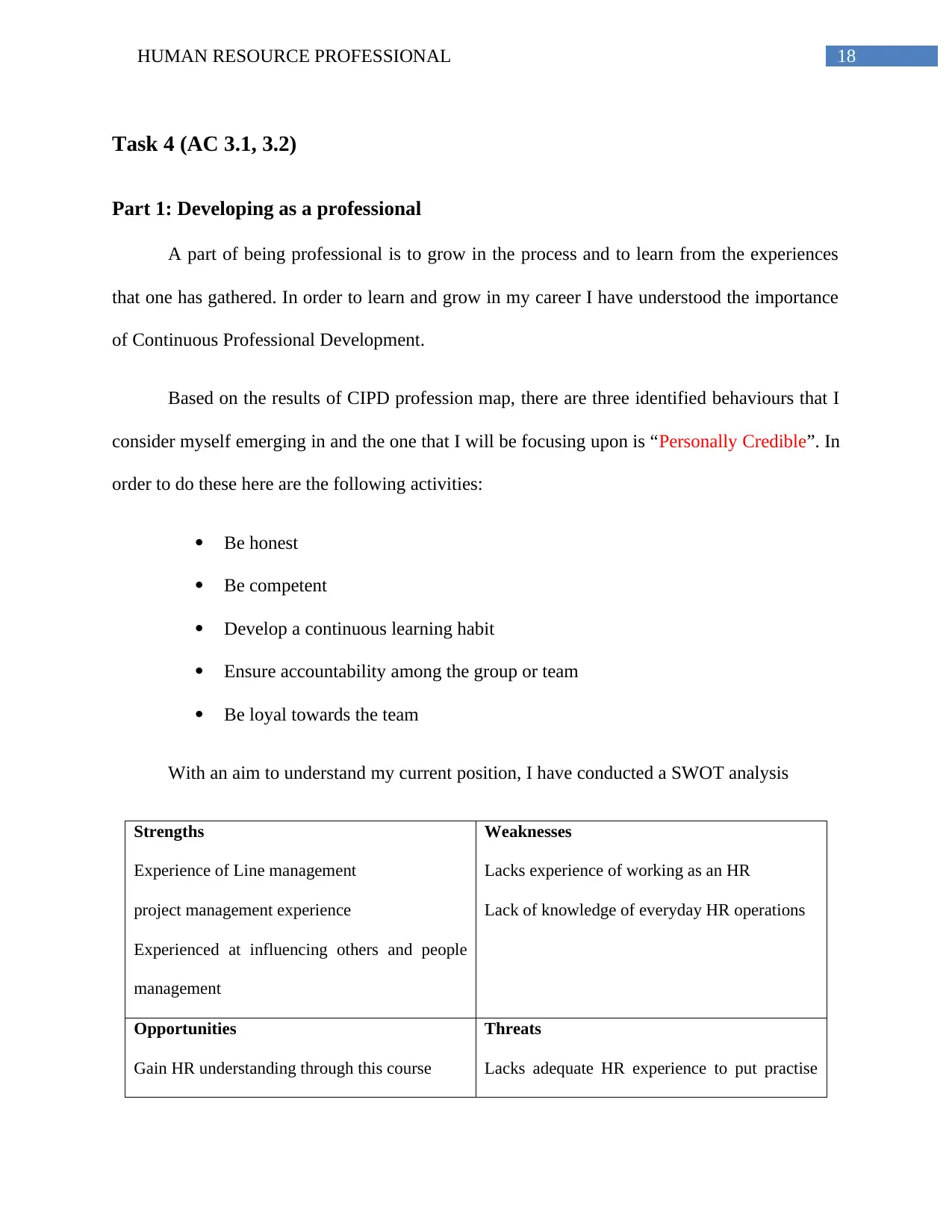
Task 4 (AC 3.1, 3.2)
Part 1: Developing as a professional
A part of being professional is to grow in the process and to learn from the experiences
that one has gathered. In order to learn and grow in my career I have understood the importance
of Continuous Professional Development.
Based on the results of CIPD profession map, there are three identified behaviours that I
consider myself emerging in and the one that I will be focusing upon is “Personally Credible”. In
order to do these here are the following activities:
Be honest
Be competent
Develop a continuous learning habit
Ensure accountability among the group or team
Be loyal towards the team
With an aim to understand my current position, I have conducted a SWOT analysis
Strengths
Experience of Line management
project management experience
Experienced at influencing others and people
management
Weaknesses
Lacks experience of working as an HR
Lack of knowledge of everyday HR operations
Opportunities
Gain HR understanding through this course
Threats
Lacks adequate HR experience to put practise
Paraphrase This Document

Working alongside the HR team on projects
and understand multiple perspectives
into theory
Part 2 Personal Development Plan
Based on the above discussions I have outlined a personal development plan to prosper in
my role as an effective and efficient HR professional. As of now I more outcomes focussed and
the strategy would be to aim for success through achieving set targets. This CIPD mapping
would enable to understand my strength and weakness better and facilitate my growth as a HR
professional. Refer to the PDP log in the Appendix.

References and bibliography
Costanzo, L.A. and Tzoumpa, V., 2008. Enhancing organisational learning in teams: has the
middle manager got a role?. Team Performance Management: An International
Journal, 14(3/4), pp.146-164.
Griggs, V. and Allen, J., 2018. The Value of an HR Professional Group for Organizational
Learning. International Journal of Human Resource Development Policy, Practice and
Research, 3(1).
Hirsh, W., 2003. Chartered Institute of Personnel and Development. Managing employee careers,
issues, trends and prospects.
Kerzner, H. and Kerzner, H.R., 2017. Project management: a systems approach to planning,
scheduling, and controlling. John Wiley & Sons.
Marchington, M., Wilkinson, A., Donnelly, R. and Kynighou, A., 2016. Human resource
management at work. Kogan Page Publishers.
Pritchard, K. and Fear, W.J., 2015. Credibility lost: attempting to reclaim an expert identity in an
HR professional context.Human Resource Management Journal, 25(3), pp.348-363.
Hirsh, W., Carter, A., Gifford, J., Strebler, M. and Baldwin, S., 2008. What customers want from
HR-The views of line managers, senior managers and employees on HR services and the HR
function. Brighton: Institute for Employment Studies, IES Report, 453.
⊘ This is a preview!⊘
Do you want full access?
Subscribe today to unlock all pages.

Trusted by 1+ million students worldwide

Sagwa, E.V., K’Obonyo, P. and Martin, O., 2015. Joint and Individual Effects of Human
Resource Management Practices, Organizational Learning, Employee Outcomes and
Competitive Strategy on Performance of Firms Listed on the Nairobi Securities Exchange.
Salas, E., Shuffler, M.L., Thayer, A.L., Bedwell, W.L. and Lazzara, E.H., 2015. Understanding
and improving teamwork in organizations: A scientifically based practical guide. Human
Resource Management, 54(4), pp.599-622.
Sheehan, C., De Cieri, H., Greenwood, M. and Van Buren, H.J., 2014. HR professional role
tensions: Perceptions and responses of the top management team. Human Resource
Management, 53(1), pp.115-130.
Paraphrase This Document
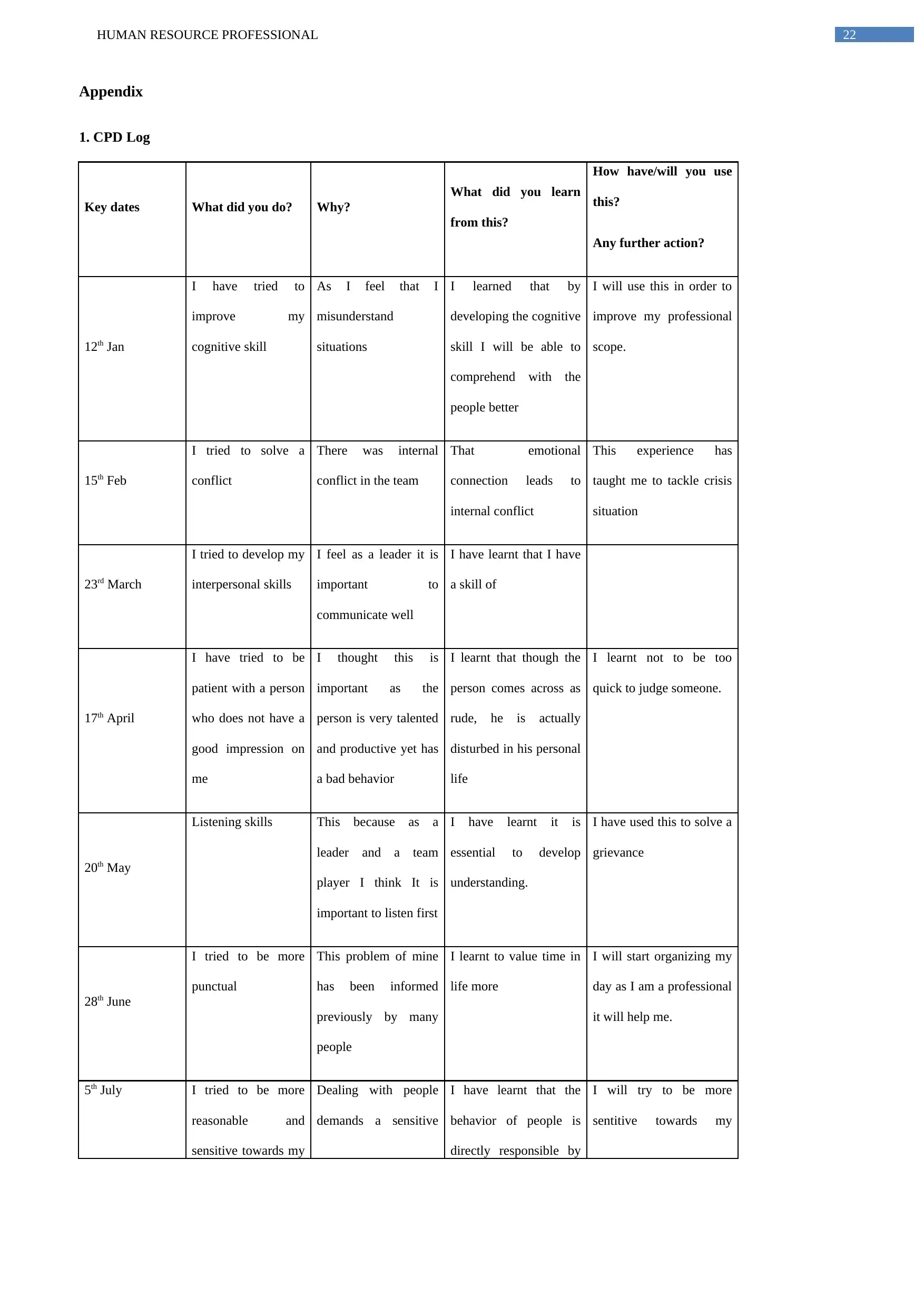
Appendix
1. CPD Log
Key dates What did you do? Why?
What did you learn
from this?
How have/will you use
this?
Any further action?
12th Jan
I have tried to
improve my
cognitive skill
As I feel that I
misunderstand
situations
I learned that by
developing the cognitive
skill I will be able to
comprehend with the
people better
I will use this in order to
improve my professional
scope.
15th Feb
I tried to solve a
conflict
There was internal
conflict in the team
That emotional
connection leads to
internal conflict
This experience has
taught me to tackle crisis
situation
23rd March
I tried to develop my
interpersonal skills
I feel as a leader it is
important to
communicate well
I have learnt that I have
a skill of
17th April
I have tried to be
patient with a person
who does not have a
good impression on
me
I thought this is
important as the
person is very talented
and productive yet has
a bad behavior
I learnt that though the
person comes across as
rude, he is actually
disturbed in his personal
life
I learnt not to be too
quick to judge someone.
20th May
Listening skills This because as a
leader and a team
player I think It is
important to listen first
I have learnt it is
essential to develop
understanding.
I have used this to solve a
grievance
28th June
I tried to be more
punctual
This problem of mine
has been informed
previously by many
people
I learnt to value time in
life more
I will start organizing my
day as I am a professional
it will help me.
5th July I tried to be more
reasonable and
sensitive towards my
Dealing with people
demands a sensitive
I have learnt that the
behavior of people is
directly responsible by
I will try to be more
sentitive towards my
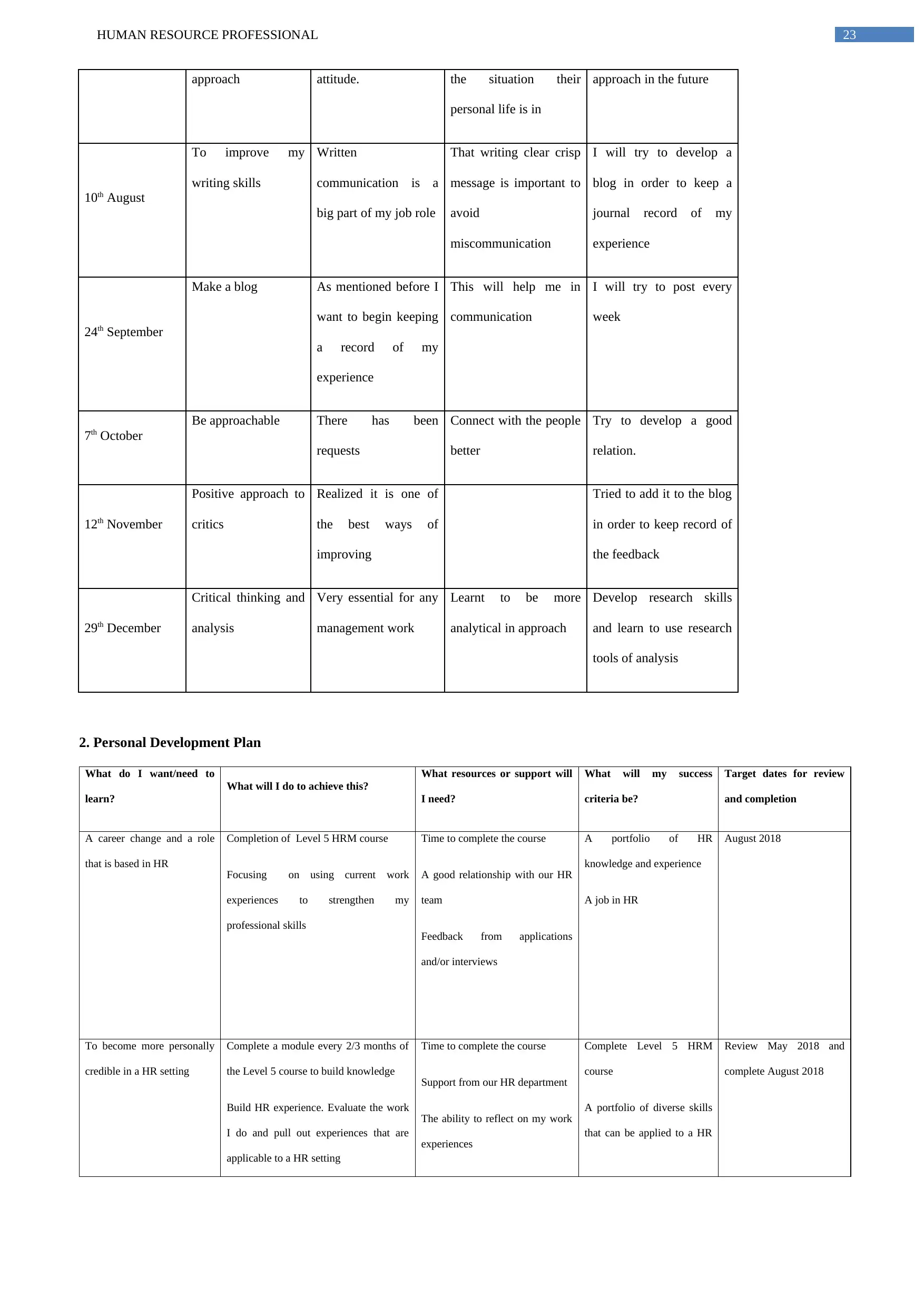
approach attitude. the situation their
personal life is in
approach in the future
10th August
To improve my
writing skills
Written
communication is a
big part of my job role
That writing clear crisp
message is important to
avoid
miscommunication
I will try to develop a
blog in order to keep a
journal record of my
experience
24th September
Make a blog As mentioned before I
want to begin keeping
a record of my
experience
This will help me in
communication
I will try to post every
week
7th October
Be approachable There has been
requests
Connect with the people
better
Try to develop a good
relation.
12th November
Positive approach to
critics
Realized it is one of
the best ways of
improving
Tried to add it to the blog
in order to keep record of
the feedback
29th December
Critical thinking and
analysis
Very essential for any
management work
Learnt to be more
analytical in approach
Develop research skills
and learn to use research
tools of analysis
2. Personal Development Plan
What do I want/need to
learn?
What will I do to achieve this?
What resources or support will
I need?
What will my success
criteria be?
Target dates for review
and completion
A career change and a role
that is based in HR
Completion of Level 5 HRM course
Focusing on using current work
experiences to strengthen my
professional skills
Time to complete the course
A good relationship with our HR
team
Feedback from applications
and/or interviews
A portfolio of HR
knowledge and experience
A job in HR
August 2018
To become more personally
credible in a HR setting
Complete a module every 2/3 months of
the Level 5 course to build knowledge
Build HR experience. Evaluate the work
I do and pull out experiences that are
applicable to a HR setting
Time to complete the course
Support from our HR department
The ability to reflect on my work
experiences
Complete Level 5 HRM
course
A portfolio of diverse skills
that can be applied to a HR
Review May 2018 and
complete August 2018
⊘ This is a preview!⊘
Do you want full access?
Subscribe today to unlock all pages.

Trusted by 1+ million students worldwide

role
Become more curious,
reflect on what I learn and to
use it to help me develop
Ask for a HR mentor at work to be able
to reflect on my own work and also to
understand theirs
Ensure I read a range of information
when completing each assignment
Talk to other HR professionals in other
industries
Networking to meet other HR
professionals
Support from our HR team
Passing modules
Build up a reflective log
I feel this is ongoing but
would look to review it
every 3 months
Review: December 2017
To gain the following
experiences and skills that
are identified in the Role
Model section of the CIPD
CPD map.
Understand legislation
Ensure I am complying and be able to
demonstrate compliance
Support from HR department and
organisational guidance
Demonstrate I comply and to
be able to offer examples
August 2018
Paraphrase This Document

Related Documents
Your All-in-One AI-Powered Toolkit for Academic Success.
+13062052269
info@desklib.com
Available 24*7 on WhatsApp / Email
![[object Object]](/_next/static/media/star-bottom.7253800d.svg)
© 2024 | Zucol Services PVT LTD | All rights reserved.





![5DVP: Developing Professional Practice Report - [University Name]](/_next/image/?url=https%3A%2F%2Fdesklib.com%2Fmedia%2Fimages%2Frq%2Fd1f1fed29d4c4b72b622be5f5f3b52cf.jpg&w=256&q=75)